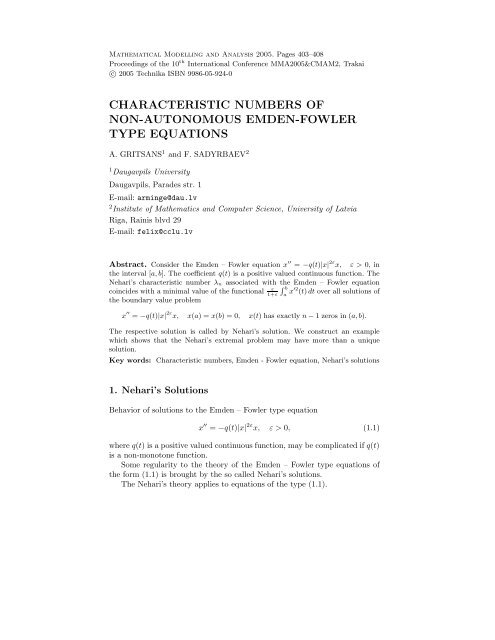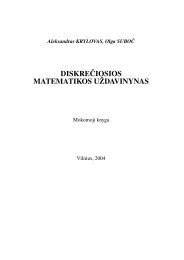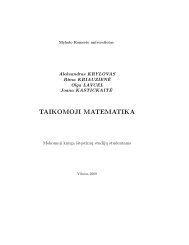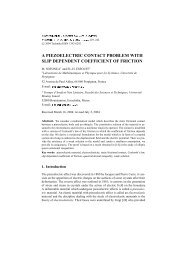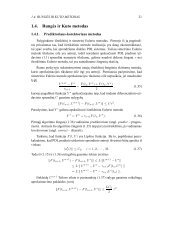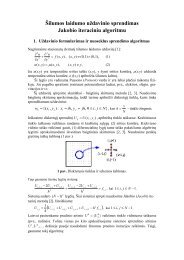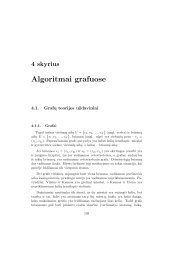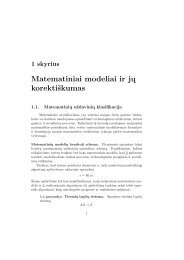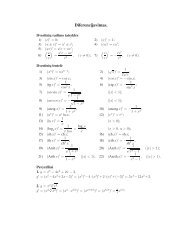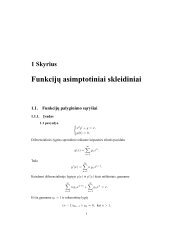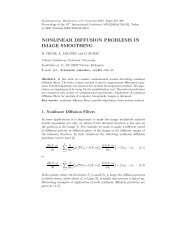characteristic numbers of non-autonomous emden-fowler type ...
characteristic numbers of non-autonomous emden-fowler type ...
characteristic numbers of non-autonomous emden-fowler type ...
You also want an ePaper? Increase the reach of your titles
YUMPU automatically turns print PDFs into web optimized ePapers that Google loves.
Mathematical Modelling and Analysis 2005. Pages 403–408Proceedings <strong>of</strong> the 10 th International Conference MMA2005&CMAM2, Trakaic○ 2005 Technika ISBN 9986-05-924-0CHARACTERISTIC NUMBERS OFNON-AUTONOMOUS EMDEN-FOWLERTYPE EQUATIONSA. GRITSANS 1 and F. SADYRBAEV 21 Daugavpils UniversityDaugavpils, Parades str. 1E-mail: arminge@dau.lv2 Institute <strong>of</strong> Mathematics and Computer Science, University <strong>of</strong> LatviaRiga, Rainis blvd 29E-mail: felix@cclu.lvAbstract. Consider the Emden – Fowler equation x ′′ = −q(t)|x| 2ε x, ε > 0, inthe interval [a, b]. The coefficient q(t) is a positive valued continuous function. TheNehari’s <strong>characteristic</strong> number λ n associated withRthe Emden – Fowler equationε bcoincides with a minimal value <strong>of</strong> the functional1+ε a x′2 (t) dt over all solutions <strong>of</strong>the boundary value problemx ′′ = −q(t)|x| 2ε x, x(a) = x(b) = 0, x(t) has exactly n − 1 zeros in (a, b).The respective solution is called by Nehari’s solution. We construct an examplewhich shows that the Nehari’s extremal problem may have more than a uniquesolution.Key words: Characteristic <strong>numbers</strong>, Emden - Fowler equation, Nehari’s solutions1. Nehari’s SolutionsBehavior <strong>of</strong> solutions to the Emden – Fowler <strong>type</strong> equationx ′′ = −q(t)|x| 2ε x, ε > 0, (1.1)where q(t) is a positive valued continuous function, may be complicated if q(t)is a <strong>non</strong>-monotone function.Some regularity to the theory <strong>of</strong> the Emden – Fowler <strong>type</strong> equations <strong>of</strong>the form (1.1) is brought by the so called Nehari’s solutions.The Nehari’s theory applies to equations <strong>of</strong> the <strong>type</strong> (1.1).
404 A. Gritsans, F. SadyrbaevThe general theorem by Nehari ([2, Theorem 3.2]) when adapted to thecase under consideration states that the extremal problem below has a solution.Problem:H(x) =∫ ba[x ′2 − (1 + ε) −1 q(t)x 2+2ε] dt → inf, x ∈ Γ n , (1.2)where Γ n consists <strong>of</strong> all functions x(t), which are continuous and piece-wisecontinuously differentiable in [a, b]; there exist <strong>numbers</strong> a ν such thata = a 0 < a 1 < . . . < a n = b;x(a 0 ) = 0 and for ν = 1, . . . , n, x(a ν ) = 0 but x ≢ 0 in any [a ν−1 , a ν ], and∫ aνa ν−1x ′2 (t) dt =∫ aνa ν−1q(t)x 2 |x| 2ε dt. (1.3)The respective extremal functions x n (t) are those solutions <strong>of</strong> equation(1.1), which vanish at the points t = a and t = b, have exactly n − 1 zeros in(a, b) and satisfy the condition∫ bax ′2 dt =∫ bBy combining (1.3) with (1.4) one getsλ n (a, b) := min H(x) = H(x n ) =εx∈Γ n 1 + εaq(t)x 2 |x| 2ε dt. (1.4)∫ baq(t)x 2+2ε dt =ε1 + ε∫ bax ′2 (t) dt.Thus the <strong>characteristic</strong> number λ n (a, b) is (up to a multiplicative constant)a minimal value <strong>of</strong> the functional ∫ ba x′2 (t) dt over the set <strong>of</strong> all solutions <strong>of</strong>the boundary value problemx ′′ = −q(t)|x| 2ε x, x(a) = x(b) = 0, x(t) has n − 1 zeros in (a, b).We will call the <strong>characteristic</strong> <strong>numbers</strong> λ n by the Nehari’s <strong>numbers</strong> andthe respective solutions <strong>of</strong> the differential equation by the Nehari’s solutions.Remark 1. Nehari’s <strong>numbers</strong> λ n (a, b) are uniquely defined by the interval(a, b). In the work [2] Nehari mentioned that the theory could be developedmush easier if the associated Nehari’s solution be unique. It was shown theoreticallyin [3] that this is not the case. There exist equations <strong>of</strong> the <strong>type</strong>(1.1), which have more than one Nehari’s solution for certain a, b and n.2. Example: Nonuniqueness <strong>of</strong> the Nehari’s SolutionsWe construct the Emden - Fowler equation which possesses two Nehari’s solutions.
Characteristic Numbers <strong>of</strong> Emden – Fowler Equations 405In our considerations we use systematically the lemniscatic functions sl tand cl t which can be defined as solutions <strong>of</strong> the equation x ′′ = −2x 3 , subjectto the initial conditions x(0) = 0, x ′ (0) = 1 and x(0) = 1, x ′ (0) = 0respectively. Both functions are periodic with a minimal period <strong>of</strong> 4A, whereA =∫ 10ds√ . One may consult the paper [1] for more properties <strong>of</strong> these1 − s4functions. In many respects they behave like usual trigonometric functions.Equation. Consider equationtogether with the boundary conditionsx ′′ = −q(t) x 3 , t ∈ (−1, 1), (2.1)x(−1) = 0, x(1) = 0, x(t) > 0, t ∈ (−1, 1). (2.2)The coefficient q(t) is constructed as follows. Letq(t) =2(ξ(t)) 6,whereandξ(t) ={ξ1 (t), −1 ≤ t ≤ 0,ξ 2 (t), 0 ≤ t ≤ 1ξ 1 (t) = ht + η, −1 ≤ t ≤ 0,ξ 2 (t) = −ht + η, 0 ≤ t ≤ 1.Thus ξ(t) is a “Λ-shaped” piece-wise linear function, which depends on apositive valued parameter h, η depends on h as η = h + 1.Solutions. Our goal: we are looking for a solution (solutions) <strong>of</strong> the problem(2.1), (2.2).Consider two problemsk1 = −(ht + η) 6 x3 1, x 1 (−1) = 0, x 1 (0) = τ, x 1 (t) > 0, t ∈ (−1, 0);x ′′x ′′2 = − k(−ht + η) 6 x3 2 , x 2(0) = τ, x 2 (1) = 0, x 2 (t) > 0, t ∈ (0, 1),where τ > 0. Letx 1 (t) be a solution <strong>of</strong> the first equation <strong>of</strong> (2.3) in [−1; 0];x 2 (t) be a solution <strong>of</strong> the second equation <strong>of</strong> (2.3) in [0; 1].(2.3)
406 A. Gritsans, F. SadyrbaevThen the functionx(t) ={x1 (t), if −1 ≤ t ≤ 0,x 2 (t), if 0 ≤ t ≤ 1is a C 2 -solution <strong>of</strong> the problem (2.1), (2.2) if additionally the smoothnessconditionx ′ 1(0) = x ′ 2(0)is satisfied. The problem (2.3) can be explicitly resolved as( )x 1 (t, β 1 ) = β 1 21 (ht + η) · sl β 1 t + 121 ,ht + ηwhereandβ 1 = x ′ 1 (−1) > 0x 1 (0; β 1 ) = τ.The derivative is given by( )( )x ′ 1(t; β 1 ) = β 1 21 h · sl β 1 t + 1 −h + η21 + β 1ht + η ht + η · sl′ β 1 t + 121 .ht + ηSimilar formulas are valid for x 2 (t). Notice that x ′ 2 (1) = −β 2 < 0. In orderto get an explicit formula for a solution <strong>of</strong> the BVP (2.1), (2.2) one have tosolve a system <strong>of</strong> two equations with respect to (β 1 , β 2 )x 1 (0; β 1 ) = x 2 (0; β 2 ),x ′ 1(0; β 1 ) = x ′ 2(0; β 2 ).This system after replacements and simplifications looks as⎧ ( ) ( )⎪⎨ β 1 β 1 221 · sl 1= β 1 β 1 22η 2 · sl 2,η( ))( )⎪⎩ β 1 β 1 221 h · sl 1+ β 1(β 1 2η η · 1 sl′ = −β 1 β 1 22η2 h · sl 2− β 2(β 1 2η η · 2 sl′ η),where 0 < β 1 2 1η, β 2 1 2η< 2A. In new variables u := β 2 1 1η, v := β 1 2 2ηthe systemtakes the form{ u sl u = v sl v, 0 < u, v < 2A,hu sl u + u 2 sl ′ u = −hv sl v − v 2 sl ′ v, h > 0.(2.4)Notice that if a solution (ū, ¯v) <strong>of</strong> the system (2.4) exists, then a solution x(t)<strong>of</strong> the BVP (2.1), (2.2) can be constructed such thatx ′ (−1) = β 1 = ū 2 (h + 1) 2 , x ′ (1) = −β 2 = −¯v 2 (h + 1) 2 .
Characteristic Numbers <strong>of</strong> Emden – Fowler Equations 407Proposition 1. For h large the system (2.4) has exactly three solutions, whichhave the following <strong>characteristic</strong>s.1. There exists a unique symmetric solution (u 0 , v 0 ), that is, u 0 = v 0 . Onehas that (u 0 , v 0 ) → (2A, 2A) as h → +∞.2. There exists a unique solution (u 1 , v 1 ) in the triangle {0 < u, v < 2A, v >u)} for h large. Moreover, (u 1 , v 1 ) → (0, 2A) as h → +∞.3. There exists a unique solution (u 2 , v 2 ) in the triangle {0 < u, v < 2A, v 1are depicted in the Figure 1. Notice that a set <strong>of</strong> zeros <strong>of</strong> Φ consists <strong>of</strong> thediagonal u = v and two symmetric branches.2A2.521.510.50.5 1 1.5 2 2.52AFigure 1. Zeros <strong>of</strong> Φ(u, v) (solid line) and Ψ(u, v) (dashed line), h = 2.Nehari’s <strong>numbers</strong>. The respective solutions <strong>of</strong> the boundary value problem(2.1), (2.2) look as shown in the picture.30252015105-1 -0.5 0.5 1Let H = 1 21∫−1x ′2 (t)dt. Denote by H sym and H asym the respective values<strong>of</strong> H for a symmetric solution (which is depicted by solid line), and for asymmetricsolutions (depicted by dashed lines). Notice that H(x) is the same forboth asymmetric solutions. The values <strong>of</strong> H sym and H asym are
408 A. Gritsans, F. Sadyrbaev( ( ) (H sym = 2 3 u 3 2 u 2 100 h+1 − sl′ u 2 10h+1sl( ( ) (H asym = 1 3 u 3 2 u 2 111 h+1 − sl′ u 2 11h+1sl( ( ) (+ 1 3 v 3 2 v 2 111 h+1 − sl′ v 2 11h+1slProposition 2.H symH asym−−−−−→h→+∞ 2.u 1 20h+1u 1 21h+1v 1 21h+1)),)))).Therefore for h large two asymmetric solutions are the Nehari’s solutions.References[1] A. Gritsans and F. Sadyrbaev. Lemniscatic functions in the theory <strong>of</strong> theEmden-Fowler differential equation. Mathematics. differential equations (Univ.<strong>of</strong> Latvia, Institute <strong>of</strong> Math. and Comp. Sci.), 3(3), 5 – 27, 2003. (electr. versionhttp://www.lumii.lv/sbornik1/Sbornik-2003-english.htm)[2] Z. Nehari. Characteristic values associated with a class <strong>of</strong> <strong>non</strong>linear second-orderdifferential equations. Acta Math., 105(3), 141 – 175, 1961.[3] F. Sadyrbaev. On solutions <strong>of</strong> the Emden-Fowler <strong>type</strong> equation. Differentialequations, 25(5), 799 – 805 (in Russian), 1989. English translation:F.Zh.Sadyrbaev, Solutions <strong>of</strong> the Emden-Fowler <strong>type</strong> equation., Differential Equations(ISSN:0012-2661, by Kluwer Academic/Plenum Publisher) 25, No.5, 560-565 (1989)


